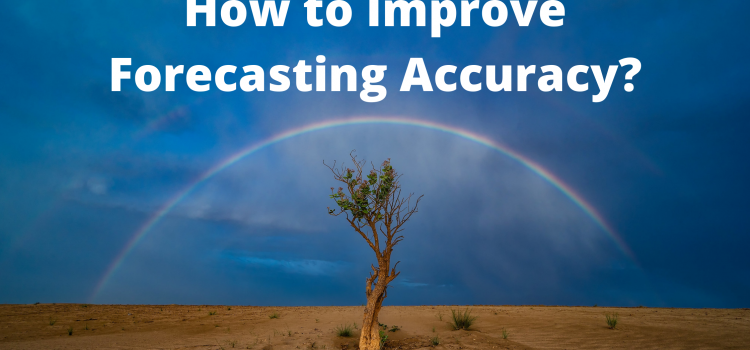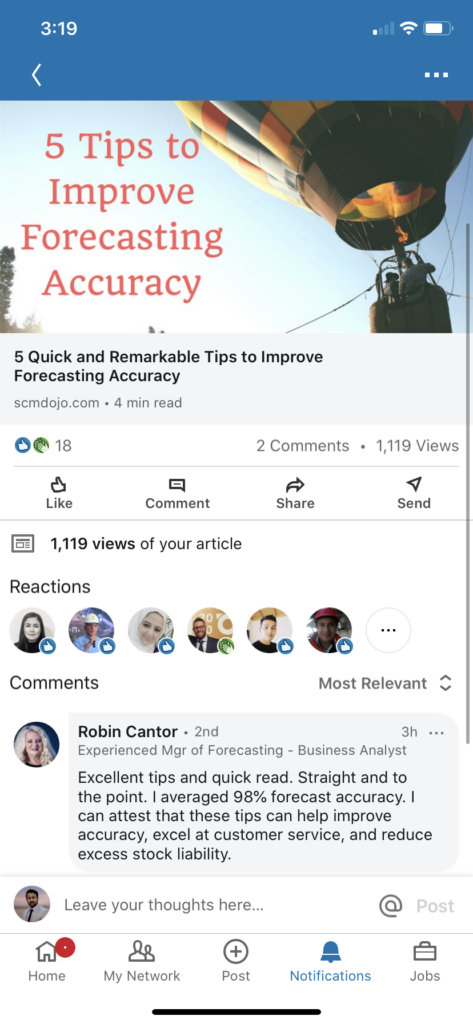Many businesses do some forecast due to its importance to the benefits it provides. However, the most business also complains about the accuracy of their forecasting process and want to know how they can improve forecasting accuracy.
Supply Chain Management is a broad umbrella of complex functions aligned to meet one common goal – customer satisfaction. Customers may walk into your store or browse your website to purchase their products. What happens if your store understocks the item and it is not available? The customer may wait for backorders, but due to various reasons, they may instead search for a similar product with another store, causing a loss in sales. In either case, the customer is unhappy, which equates to a loss for the owners. So let me break it down to a simple equation, to achieve customer satisfaction and make a profit, it is necessary to ensure supply meets demand. This equation can be satisfied by utilizing the forecasting technique. Forecasting is predicting the future based on past and present data. Forecasting is a great technique to ensure you are carrying the right amount of inventory for the months to come. The future demand can be predicted weeks to months in advance using various supply chain forecasting software. In all cases, the forecast will have some level of uncertainty.
In the words of Ned Davis..
After studying forecast day and night for over 30 years…I’ve yet to find anyone who could consistently and relably forecast an uncertain future
There are two common methods of forecasting: qualitative and quantitative. When historical data is unavailable, the qualitative method comes in handy. This method usually consists of Delphi techniques, reviewing sales force estimates, market research, expert judgment and panel consensus. This method is not very reliable or accurate. So if you are looking for consistent accuracy, quantitative should be your method of choice. Quantitative forecasting is not only reliable and accurate but also enables customer satisfaction and keeps vendors happy without having to deal with rush orders. The quantitative technique plays with the previously available data and shows a pattern in trend analysis. The common quantitative methods used are Moving Average Range and Exponential Smoothing.
Having said that is much easy to use forecasting software available, which does everything from sales, forecasts, KPIs, and dashboards. All in one place, that’s easy to analyze! The software is specifically for S&OP Managers, Supply Chain Managers, and Demand Planners. You can start using it for free and if you find it useful, you can move to a cost-effective Launch plan.
Get The Ultimate Guide to Demand Forecasting
And if you are looking to improve the way you run the S&OP process, you must benefit from this practical hands-on course
Importance of Forecasting Accuracy:
Research shows that Business Analysts utilize supply chain software with forecasting tools to predict demand to always have supplies on hand. When the demand is underestimated, it means the company does not have enough stock to satisfy all of its customers. In such cases, loyal customers may decide to wait until the product is back on the market, but new customers who need the product immediately will turn to your competitors. Companies often tend to rush orders to suppliers to stop their customers from walking away, but this only worsens the situation for them, as they end up paying double the amount to the suppliers, which leads to a reduction in profit and net income.
You may think it is better to have extra inventory on hand to avoid the hassle of last-minute orders, but overestimation of demand has a consequence too. When a company carries extra stock, it becomes more of a liability than an asset. There are various costs associated with inventory like labour costs, holding costs and storage costs (in case inventory needs to be moved to a different DC). Excess inventory is equivalent to waste, especially per perishable goods. It is a barrier to growth and blocks the distribution network. Therefore, holding excess stock is not a solution. It will lead to a decrease in profit margins. Carrying enough stock to meet demand is the optimal solution to achieve & improve forecasting accuracy.
Tips to Improve Forecasting Accuracy:
1. Set your Forecast Level Closer to the Customers:
We know that the supply chain involves a large ecosystem of people and processes. So we also know that there are various levels in the supply chain between the suppliers and end-consumers. With the large number of people involved, internal and external inventory drivers and policies, there are high chances of data and information being distorted. This leads to inefficiency in forecasting and inventory at supply chain levels. This phenomenon is called the Bullwhip Effect. This makes it very important to ensure the forecasts are made at the customer level to improve forecasting accuracy and communication.
2. Filter the Forecasting Down to Exceptions:
Forecasting software archives previous demand data, of which some items are no longer available or one-time variables. Instead of reviewing the large database for all previous data, companies should filter the data that is relevant and of importance. The best way to do this is to categorize inventory based on ABC analysis which will help focus on items of high demand first and low demand last.
3. Focus on the Demand Forecast, not the Sales Forecast:
Throughout the article, I mentioned that the key to forecasting is matching supply to demand. But the key to improving forecasting accuracy is treating the two as separate variables. When a company is exhausted on a product line, it means that there have been no sales for that particular product for as long as they were in stock out. The demand may still be pouring in, except it cannot be met until the product is replenished. This is the truth of the demand side. But on the sales side, history shows there have been no sales as there was no demand. This difference in data types can be very crucial in forecasting, and hence demand data should be utilized.
4. Identify Distorted Demand Data:
Companies sometimes set a minimum requirement on orders to reach their desired sales point. By inflicting parameters like batch size, minimum order quantity, sales incentives etc., the demand data is distorted because customers end up ordering the minimum quantity to fulfill their orders. This is inaccurate as it does not signify the actual demand. This can diminish forecasting accuracy and needs to be identified and eliminated.
5. Evaluate the Forecast Accuracy:
Some tools can be used to evaluate the forecasting accuracy, which will help monitor the progress and report the outcome to sponsors. Evaluating the forecast will give the forecasting team an overview of their performance over the period of time. For analysts who have been doing exceptionally well, this will boost their performance to achieve continued accuracy and deliver outstanding results. For those who have been giving an average performances, this will act as a wake-up call to step up their game. Once a process is in place, it can be documented and used for future reference. Evaluating forecast accuracy is undoubtedly the most crucial step to improving forecasting accuracy!
6. Track Competiton Activities Continuously:
Sometimes there is a severe stockout situation with competition, which forces the competition customers to place demand for your product. It has happened many times in my 15 years of demand forecasting. So, if you don’t have ears on the ground, you will get caught, and when a demand surge comes towards your product, you will be in stock-out situation. Moreover, track the promotional activities of the customers, as it could also impact your demand. For example, if your customer is offered a buy-one-get-one-free offer, it is bound to impact your demand negatively.
Get Inventory Optimization Tool
7. Impact on Forcast Due to Natural Causes:
COVID-19 has taught us many things, from the acceleration of digitalization to forcing people to wear masks and sanitize their hands. But from a demand forecasting perspective, natural calamities such as COVID-19 also affect sales of many products. As you know, Mask and sanitiser demand has gone through the roof, but it has also impacted negatively specific industries. For example, demand for car parts has gone down as they are driving less.
And if you don’t believe me look at the testimonial from Robin Cantor – an experienced manager of forecasting, confirming these tips works.
Now you know why forecasting is so important and what you need to do to improve forecasting accuracy. If you have any more tips for improving forecasting accuracy, please leave your comments below. I would like to hear from you.
Recommended Books:
This is the guest post from aspiring graduate Pranali Pawar:
Pranali Pawar is a class of 2016 graduate who holds a Master’s degree in Supply Chain & Logistics Technology from University of Houston. Her passion for supply chain management stems from her love for learning, analyzing and solving complex process optimization challenges. Coming from a business family, she has always been intrigued by the impact of people and processes in supply chain and retail management. With her newfound interest for writing, Pranali aims at sharing and gaining knowledge by interacting with industry peers. She is driven to expand her network and build connections with industry professionals, experts and gain insight into their experiences
About the Author- Dr Muddassir Ahmed
Dr MuddassirAhmed is the Founder & CEO of SCMDOJO. He is a global speaker, vlogger and supply chain industry expert with 17 years of experience in the Manufacturing Industry in the UK, Europe, the Middle East and South East Asia in various Supply Chain leadership roles. Dr. Muddassir has received a PhD in Management Science from Lancaster University Management School. Muddassir is a Six Sigma black belt and founded the leading supply chain platform SCMDOJO to enable supply chain professionals and teams to thrive by providing best-in-class knowledge content, tools and access to experts.
You can follow him on LinkedIn, Facebook, Twitter or Instagram









